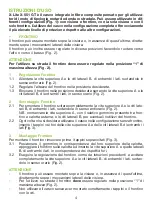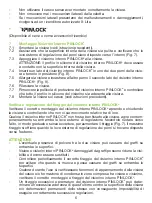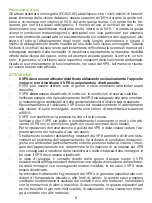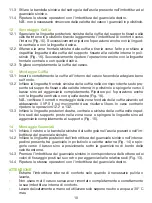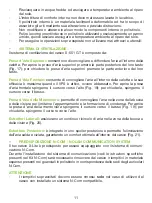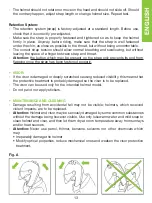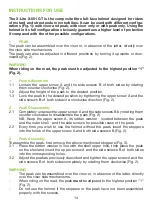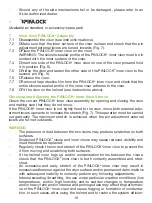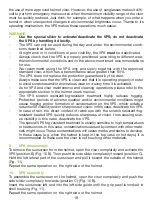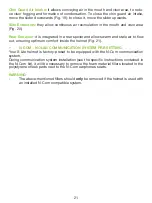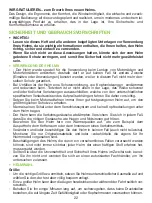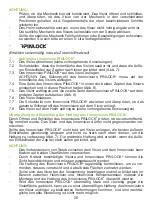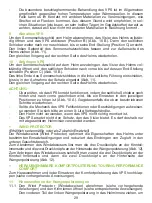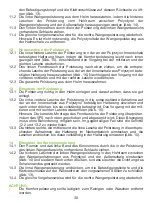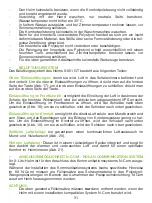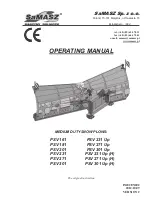
the use of mere approved helmet visor. However, the use of sunglasses makes it diffi-
cult to perform emergency manoeuvres when the maximum visibility range of the visor
must be quickly restored. Just think, for example, of what happens when you enter a
tunnel or when unexpected changes in environmental brightness occur. Thanks to its
operating mechanism, the VPS makes these operations much easier.
WARNING
-
Use the special slider to activate/deactivate the VPS; do not deactivate
the VPS by handling it directly.
-
The VPS can only be used during the day and under the environmental condi-
tions described before.
-
At night and/or in conditions of poor visibility, the VPS
must
be deactivated.
-
Always check that the VPS is properly positioned according to different wea-
ther/environmental conditions and/or the above-mentioned recommendations
for use.
-
We recommend using the VPS only and solely together with the approved
standard visor, which has a transmittance value greater than 80%.
-
The VPS does not replace the protection guaranteed by the visor.
-
Always make sure that the VPS is clean and that it is operating properly in order
to avoid scratches and/or anomalous wear on it every time it is activated.
-
As for VPS and visor maintenance and cleaning operations, please refer to the
appropriate section in the helmet user’s manual.
-
The VPS scratch resistant/fog-resistant treatment highly reduces fogging.
Protracted periods of adverse weather and/or environmental conditions might
cause fogging and/or formation of condensation on the VPS, which entails a
reduction of visibility and/or sharpness of vision: in this case, deactivate the VPS.
-
In case of rain, the direct contact of raindrops with the scratch resistant/fog-
resistant treated VPS quickly reduces sharpness of vision, thus causing scar-
ce visibility: in this case, deactivate the VPS.
-
The special VPS fog-resistant treatment is usually sensitive to high temperatures
or heat sources. In this case, contaminations caused by contact with other mate-
rials might occur. These contaminations will cause marks and stains to develop.
In these cases (e.g. when the helmet is kept in the top case on hot days), it is
recommended to make sure the visor is not touching other materials.
9
VPS disassembly
To remove the sunscreen from the helmet, open the visor completely and activate the
VPS (position B) (Fig. 10 B). Then push the side slider completely forward (position C).
Hold the left lateral part of the sunscreen and pull it toward the outside of the helmet
(Fig. 11).
Repeat the same operation on the right side of the helmet.
10
VPS Assembly
To assemble the sunscreen on the helmet, open the visor completely and push the
side slider completely forwards (position C) (Fig. 10 B).
Insert the sunscreen left end into the left side guide until the grip pawl is hooked in
shell housing (Fig. 11).
Repeat the same operation on the right side of the helmet.
18
Summary of Contents for X-551GT
Page 82: ...82 design A...
Page 83: ...83 E v A...
Page 91: ...91 X 551 GT 17 VPS 18 19 20 21 N COM NOLAN COMMUNICATION SYSTEM X Lite N Com N Com N Com N Com...
Page 92: ...Fig 4 Fig 5 Fig 2 Fig 3 Fig 6 B1 B2 C1 D2 D1 C2 A Fig 1 B 1 2 A B A...
Page 93: ...MIN MAX Fig 8 Fig 9 Fig 7 Fig 10 B Fig 10 A A B B C Fig 12 Fig 11...
Page 94: ...Fig 13 Fig 14 Fig 15 Fig 16 Fig 17 Fig 18...
Page 95: ...Fig 19 Fig 20 Fig 21...

